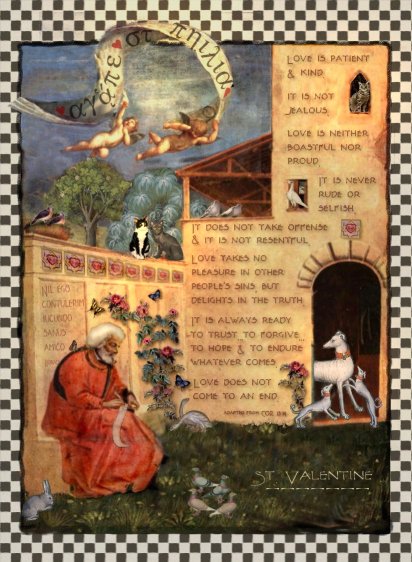Some of the symbolic imagery:
Valentine is writing messages, while homing pigeons wait at his feet. A pair of carrier pigeons is nesting in a window. Doves, geese, and passenger pigeons are also paired.
Graffiti on one wall is adapted from I Corinthians Chapter 13, describing the nature of Love. A small cat (my cat, Calpurnia, actually) sits next to the words “Love is patient and kind. It is not jealous.” She is looking at two other cats (Ivan and Little Cat/Spirit who belong to a dear friend of mine whose last name is “Love.”) sitting close together on the wall.
A mother greyhound stands with her two pups, and a rabbit symbolizes fertility. Roses climb the wall; the tiles are glazed with heart motifs and the grafitti behind Valentine is latin from Horace: While I am sane I shall compare nothing to the joy of a friend.
Cherubs hold a banner emblazoned with the Greek words for the various types of love. In an epistle the apostle Paul wrote to the Corinthians, he defines love.
Agápe: Christian Love. In Latin, it is c(h)aritas, thus the English charity or cherish—an unselfish, unconditional love.
Philía: Platonic Love or the love between friends.
Storgé: Familial Love, especially between parents and children, but also among close relatives.
Éros: Love that accompanies physical attraction.
Note: The head of St. Valentine is that of Frederick Douglass. Born a slave in the month of February, he was lovingly referred to by his mother as her “Little Valentine.” His actual birth date was never recorded, so he adopted February 14th as his official birthday. As a great man who defied the limited expectations of his day, Douglass rose from bondage to become world-famous as an abolitionist, a women’s rights activist, a spellbinding orator, and a champion of social justice for all people.

